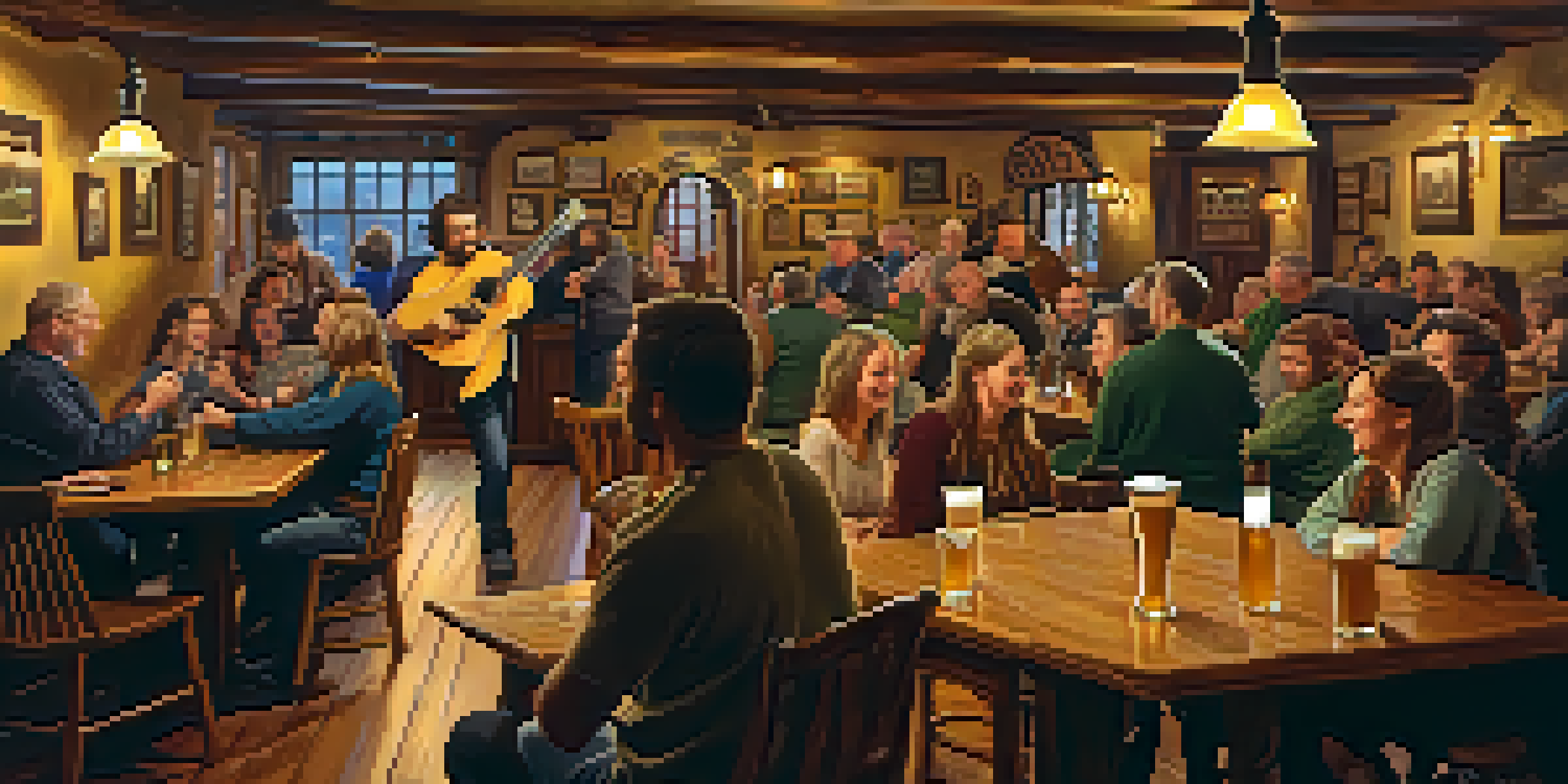Celtic Guitar: Melodic Traditions from the British Isles

The Rich History of Celtic Music and Guitar
Celtic music boasts a vibrant history that dates back centuries, deeply rooted in the cultures of the British Isles. The guitar, though a more recent addition, has woven itself into this tapestry, enriching the traditional soundscape. Its versatility allows it to adapt to various styles, from lively jigs to soulful ballads, creating a unique blend of old and new.
Music is the shorthand of emotion.
In the past, instruments like the harp and fiddle dominated the scene, but as the guitar gained popularity, it became a favored accompaniment. The transition from folk to modern Celtic music showcased the guitar's ability to bridge generations, captivating both traditionalists and newcomers alike. This evolution reflects the ongoing dialogue between heritage and innovation in Celtic traditions.
Today, many artists incorporate the guitar in ways that honor its roots while pushing creative boundaries. By blending various genres, such as rock and pop, with traditional Celtic melodies, musicians breathe new life into age-old tunes. This fusion exemplifies how the guitar has become an essential element of contemporary Celtic music.
Understanding Celtic Guitar Techniques
Celtic guitar techniques are as diverse as the music itself, often drawing from both traditional fingerstyle playing and contemporary strumming patterns. One popular method is the use of alternate picking, which creates a rhythmic flow that pairs beautifully with traditional melodies. This technique allows musicians to capture the essence of Celtic tunes while adding their unique flair.

Another common technique is the use of open tunings, which can enhance the resonant qualities of the guitar. By tuning the strings to specific pitches, players can achieve a fuller sound that complements the melodic lines of traditional tunes. These tunings often evoke a sense of nostalgia, transporting listeners to the rolling hills and bustling pubs of the British Isles.
Celtic Guitar's Evolving Role
The guitar has become an essential instrument in Celtic music, bridging traditional and contemporary styles to create a vibrant sound.
In addition, many Celtic guitarists employ embellishments such as hammer-ons and pull-offs, adding intricate details to their playing. These techniques not only showcase technical skill but also breathe life into the music, making each performance a personal expression. Through practice and experimentation, musicians can create a signature style that pays homage to their Celtic roots.
Influential Celtic Guitarists to Know
Throughout the years, several Celtic guitarists have made significant contributions to the genre, shaping its sound and inspiring future generations. One such artist is Tony McManus, known for his exceptional fingerstyle technique and ability to interpret traditional melodies. His innovative approach has garnered acclaim, making him a key figure in the Celtic guitar community.
The guitar is a miniature orchestra in itself.
Another notable guitarist is Liz Carroll, whose mastery of both the guitar and fiddle has earned her a reputation as a leading musician in Irish traditional music. Carroll’s compositions often feature intricate melodies and harmonies, showcasing the guitar's versatility as both a lead and accompaniment instrument. Her work exemplifies the fusion of tradition and creativity in Celtic music.
Lastly, we cannot overlook the contributions of John Doyle, whose rhythmic playing and inventive arrangements have captivated audiences worldwide. With a background in traditional Irish music, Doyle's style reflects a deep understanding of the genre while incorporating modern influences. These artists, among many others, continue to inspire a new generation of Celtic guitarists.
Exploring Regional Variations in Celtic Guitar
The British Isles are home to a rich tapestry of regional variations in Celtic music, each with its distinctive flair. In Ireland, for example, the guitar often complements traditional instruments like the bodhrán and tin whistle, creating a lively sound that is perfect for dances and gatherings. The vibrant rhythms and melodies echo the spirit of Irish folk culture, inviting listeners to join in the celebration.
In contrast, Scottish Celtic music tends to showcase the guitar in a more melodic role, often accompanying the haunting sounds of the bagpipes. This interplay creates a unique atmosphere, evoking images of misty highlands and ancient castles. The guitar's ability to adapt to these different settings highlights its importance in preserving and promoting regional identities.
Diverse Techniques Enhance Music
Celtic guitar techniques, such as alternate picking and open tunings, enrich the musical experience and allow for personal expression.
Furthermore, Welsh and Breton styles also add layers to the Celtic guitar tradition. In Wales, the guitar often features in folk songs, blending seamlessly with vocal harmonies to create a rich auditory experience. Meanwhile, Breton music incorporates a lively dance element, with guitarists playing rhythmically to keep the energy high. These regional variations remind us that the Celtic guitar is not a one-size-fits-all instrument but a versatile tool for expression.
The Role of the Celtic Guitar in Modern Music
In today's music landscape, the Celtic guitar continues to play a vital role in both traditional and contemporary genres. Many modern bands and solo artists incorporate the guitar to create a fresh sound while paying homage to their roots. This blend of old and new resonates with audiences, allowing them to connect with the music on a deeper level.
Moreover, the rise of digital platforms has made it easier for Celtic guitarists to share their music with a global audience. Online streaming services and social media have opened doors for collaboration and experimentation, leading to exciting new sounds within the genre. As musicians explore various influences, the Celtic guitar remains a key instrument in this ongoing evolution.
In addition, educational resources like online tutorials and workshops have emerged, empowering aspiring guitarists to learn and embrace Celtic music. These platforms encourage musicians to explore their creativity while discovering the rich history of the genre. The result is a thriving community of players who are passionate about keeping the Celtic guitar tradition alive.
Learning to Play the Celtic Guitar
If you're inspired to pick up the Celtic guitar, there are several steps to help you get started. First, familiarize yourself with common chords and finger positions, which serve as the foundation for many traditional tunes. Practicing these basics will give you the confidence to tackle more complex pieces as you progress.
Next, consider exploring various playing styles, such as fingerpicking and flatpicking, to find what resonates with you. Each technique offers a unique sound and feel, allowing you to express your musical personality. Don't be afraid to experiment with different styles, as this exploration can lead to exciting discoveries.
Future of Celtic Guitar Looks Bright
The ongoing evolution and cross-cultural collaborations in Celtic guitar music promise a future filled with innovation and creativity.
Lastly, immerse yourself in the rich repertoire of Celtic music by listening to recordings and attending live performances. Engaging with the music will deepen your understanding and inspire your playing. Joining a local group or taking lessons from experienced musicians can also provide valuable insights and help foster your growth as a Celtic guitarist.
Celebrating the Future of Celtic Guitar
As we look ahead, the future of Celtic guitar is bright, filled with endless possibilities for innovation and creativity. With each generation of musicians, new interpretations and styles emerge, keeping the tradition alive and relevant. These evolving sounds reflect the dynamic nature of Celtic music, inviting fresh perspectives and ideas.
Furthermore, the increasing interest in world music has brought Celtic guitar to a wider audience, encouraging cross-cultural collaborations. Artists from various backgrounds are incorporating Celtic elements into their work, creating a rich fusion of sounds that captures the spirit of unity. This blending of cultures enriches both the musicians and their audiences, fostering appreciation for diverse musical traditions.

Ultimately, the Celtic guitar serves as a powerful symbol of connection, bridging the past and present through its melodies. By celebrating and nurturing this tradition, we ensure that the enchanting sounds of the Celtic guitar continue to inspire and resonate for years to come. Whether you're a seasoned player or a curious listener, there's no denying the magic that this instrument brings to the world of music.